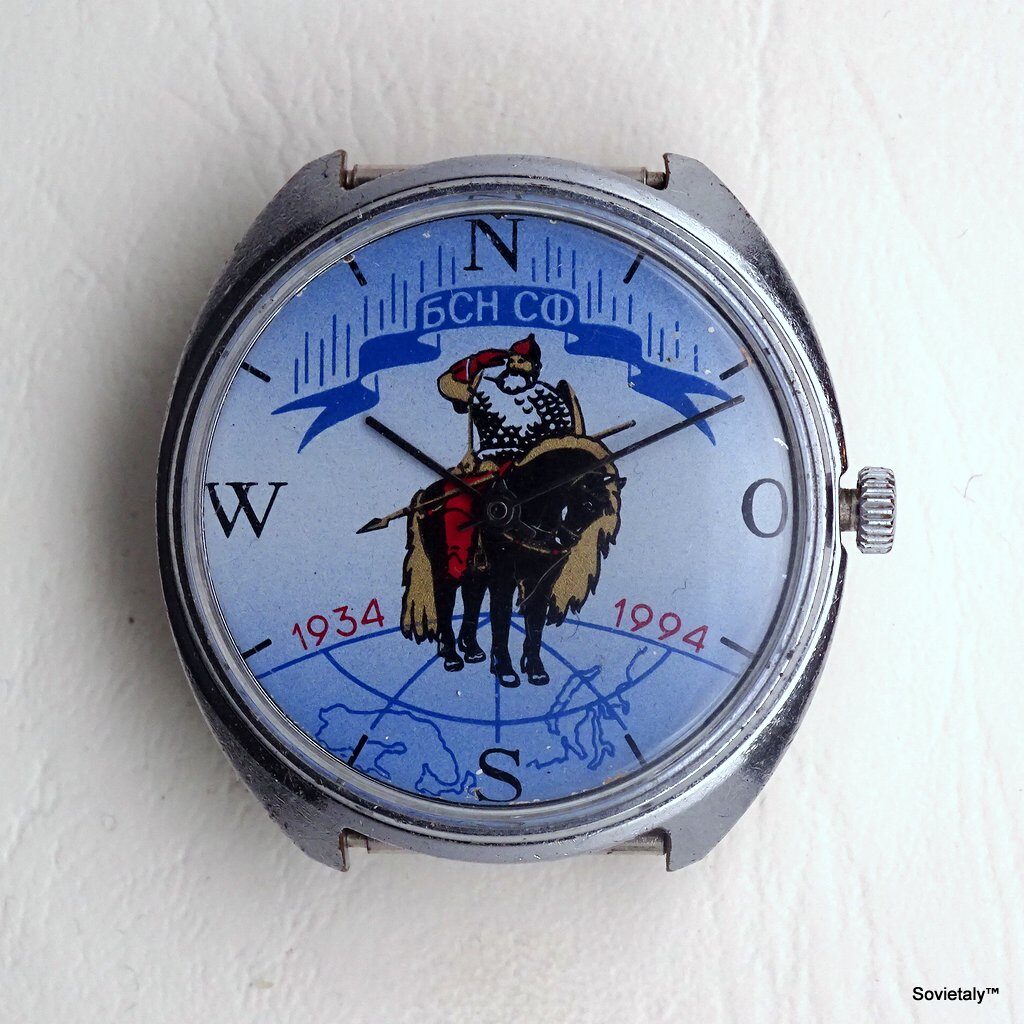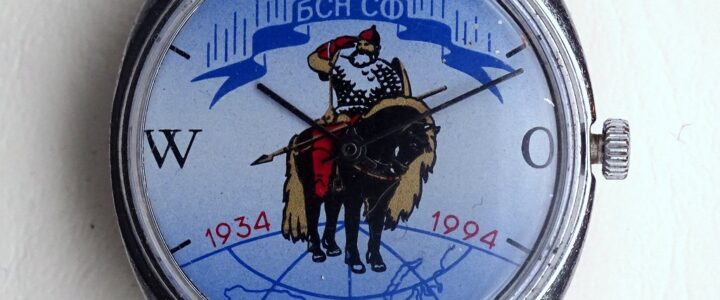Illya Muromets is a legendary figure deeply embedded in Slavic culture, celebrated through epic poems and folk tales. This iconic hero of Russian tradition symbolizes the strength and resilience of a people who have withstood countless invasions. In this article, we will explore the origins of the Muromets legend, its cultural evolution, and its impact in Russia and beyond.

The Commemorative Watch
An intriguing example of the celebration of Illya Muromets is a commemorative watch, featuring a chromed case and a plexiglass crystal. This watch uses a manually wound mechanical movement, the Raketa 2409 caliber, known for its reliability and precision. On the dial, the image of Muromets on horseback is prominent, with the dates 1934-1994 marking a significant anniversary. Above, a stylization of the aurora borealis highlights the northern latitudes associated with the legend.
Transcription and Interpretation of the Letters on the Dial
Above the figure of Muromets and below the aurora borealis, the letters “БЧ СФ” (transliterated as “BCH SF”) are present. This likely refers to “Береговая система наблюдения СЕВЕРНЫЙ ФЛОТ БСН СФ 1934-1994 60 лет на ходу.” Here is a possible translation and interpretation:
- Береговая система наблюдения: Coastal surveillance system
- СЕВЕРНЫЙ ФЛОТ: Northern Fleet
- БСН СФ: Coastal Surveillance System of the Northern Fleet (BSN SF)
- 1934-1994: Celebration of 60 years of activity (60 лет на ходу)
This interpretation indicates that the watch was produced to commemorate the 60 years of activity of the Coastal Surveillance System of the Northern Fleet, a significant military unit in the defense of Russian coasts. Learn more about the Raketa 2409 caliber.
Origins of the Legend
Illya Muromets, also known as Illya of Kiev, appears in chronicles from the 12th century, during the turbulent period of Kievan Rus, frequently threatened by nomadic incursions from the steppes. According to legend, Illya was initially a young peasant, paralyzed by illness, living in isolation in the forest. The turning point comes when, praying in an abandoned church, an old hermit predicts a heroic destiny for him. Following the hermit’s advice, Illya consumes a magical herb that miraculously restores his health and transforms him into a warrior under the service of Prince Vladimir of Kiev. Learn more about Kievan Rus and its history.
Muromets the Warrior
Distinguishing himself through strength and skill, Muromets quickly becomes a key figure in battles against the Tatars and Mongols. His legend grows, making him a symbol of resistance and warrior virtue, a living representation of Slavic heroism. Read more about the epic battles of Illya Muromets.
Cultural and Artistic Impact
The figure of Muromets has inspired artists and poets for centuries, deeply influencing Russian culture. Sometimes depicted as a superhuman giant and other times as a cunning strategist, Muromets symbolizes Slavic resilience. His deeds have been immortalized in paintings, sculptures, and film productions, cementing his place in the collective imagination of both Russian and Slavic culture. Explore artistic representations of Illya Muromets.
The Legend’s Reach in Serbia and Other Slavic Nations
Not only in Russia but also in Serbia, where he is known as Ilija Bircanin, the legend of Muromets has deep roots. Passed down through popular ballads, it has inspired literary and artistic works celebrating Serbian resistance. Discover the ballads of Ilija Bircanin.
The Watch’s Peculiarity and the Compass
The intriguing element of the watch dedicated to Muromets is the dial, which shows an “O” instead of an “E” for East. This choice can be attributed to multiple linguistic and cultural reasons. The transliteration of Russian can interpret the letter “В” as “V” or “O”, influencing representation on instruments like compasses. An alternative interpretation could link the “O” to “Orient,” the traditional term for East. In German, “Ost” (East) could also explain this choice, showing how cultural intersections influence language and art. Learn about the origins and meanings of cardinal points on compasses.
In conclusion, Illya Muromets is not just a hero from a distant era; he is a persistent symbol of Slavic culture, whose story continues to influence art, literature, and popular culture. His legacy shows how myths can transform and adapt, maintaining their significance through the centuries.


